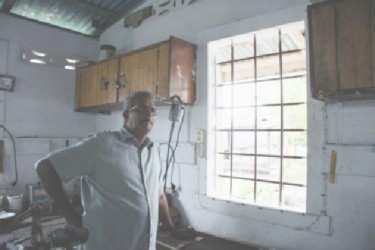Suresh Chandra Budhoo is part of a rich tradition of gold and silver jewellery production, which has long been an inherent part of the economy of the Ancient County.
He regards himself as a craftsman, insisting that “real jewellers” are creative spirits in much the same way as artists are.
The industry, however, has changed over the years. While the old-fashioned preference for hand-crafted jewellery still persists, the proliferation of moulds, imported mostly from China, has changed the face of the industry. These days, large volumes of the jewellery produced in Guyana are simply churned out from those moulds.

Moulds, Budhoo says, were introduced in the industry here about ten years ago.
He still embraces his love for hand-crafted jewellery, but he is not critical of the advent of moulds. He believes they have helped the industry. Change, he says, is inevitable with the expansion of the sector. What the introduction of moulds has also done is to allow for a broader range of consumer choice in terms of jewellery design; more than that it allows for the kind of mass production that significantly increases output.
Though he tends to stick to his hand-crafted jewellery, Budhoo is a hard-nosed businessman. The other advantage of jewellery fashioned from moulds is that it obviates the need for investment in large numbers of display pieces.
Still, he revels in discourses with customers about designs and the various sketches that precede the production of hand-made jewellery.
Budhoo’s entry into the industry came after serving three years as an apprentice. In 1999, his uncle, David Singh funded his purchase of his employer’s stall in Corriverton Market. One stall became two and he decided to enter the gold jewellery business. He established a workshop and, in 2005, he handed over the selling of the jewellery to his wife Moheni, while he remained in the workshop.
Rising gold prices, a phenomenon that was in evidence up until several weeks ago, has made the industry competitive. Berbice has its own share of jewellers and most customers are prepared to haggle over prices. Budhoo says customer retention is, in the main, a function of being able to strike a balance between delivering “quality” work and keeping prices affordable.
Life is usually much easier when the customer brings his or her own gold. That way the discussion over price does not include the issue of the price of gold.
Budhoo produces enough jewellery to require assistance, though he says that the trade does not attract too many apprentices. He is unsure as to whether any of his sons would follow him into the industry and he has one person in his employ; an apprentice whom it will take him at least a year to train.
Budhoo says an established jeweller can make “a good living”. It is, however, an industry of fluctuating fortunes. Time was when he would do as much as $500,000 per month in jobs. That is no longer the case. In fact, he says, there are days when he sells nothing. It has to do with the price of gold in recent years and, more recently, with rising unemployment in a community that is heavily dependent on the fortunes of the sugar industry.
Still, there is sufficient patronage to keep the doors of his business open, though he hastens to make the point that reduced world market prices for gold have not been attended by corresponding decreases in production costs in the local jewellery industry.
Time was when Budhoo made regular trips to Mahdia, Port Kaituma and Aranka to buy gold directly from miners. These days, he says, the risks that include malaria and robberies have brought those excursions to an end. He now buys his gold primarily from the Guyana Gold Board.
He usually anticipates the months of August, September and December. Those are his best periods and he associates those spikes in sales with the presence of overseas-based Guyanese. He has a number of repeat customers who visit him during trips home from Suriname, the Caribbean and North America. These days, he says, those visits have become fewer and while he neglects to use the word crisis to describe the condition of the industry he concedes that it is not like it used to be.
While gold remains the metal of choice in the jewellery industry, Budhoo says that silver continues to hold its own in the jewellery market. Silver, he says, lends itself to elaborate designs, is particularly popular and is considerably cheaper than gold.
Budhoo is “not complaining” about the quality of life which the jewellery trade has afforded himself and his family. He reflects on the significant role an uncle, who currently resides overseas, has played in his development as a businessman. His uncle apart, Budhoo credits the Institute of Private Enterprise Development (IPED), which offered him support after the commercial banking system had declined to help him with financing to expand his operations. He says his first loan of $500,000 was “quick and easy”.
Last year he secured an IPED entrepreneurship award but could not receive it in person since he was in Essequibo at the time. He is considering further consolidation of his business through another IPED loan when the current one is fully repaid in July.








